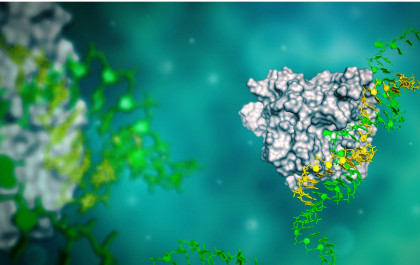ProQR Reaches Agreement with the FDA on Design of Phase 2/3 Pivotal Trial for Sepofarsen (QR-110) for Leber’s Congenital Amaurosis 10
LEIDEN, Netherlands & CAMBRIDGE, Mass., Jan. 07, 2019 (GLOBE NEWSWIRE) -- ProQR Therapeutics N.V. (Nasdaq:PRQR), a company dedicated to changing lives through the creation of transformative RNA medicines for the treatment of severe genetic rare diseases, today announced that it has reached agreement with the U.S. Food and Drug Administration (FDA) on the design of a Phase 2/3 pivotal trial (“ILLUMINATE”) for QR-110, now renamed to sepofarsen, in patients with Leber’s congenital amaurosis 10 (LCA10) due to the p.Cys998X mutation in the CEP290 gene. LCA is the leading genetic cause of childhood blindness. The trial is expected to start in the first half of 2019. We anticipate top line results for base-case of 30 trial participants around year-end 2020.
ILLUMINATE will be a randomized, double-masked, sham-controlled trial initially enrolling 30 adults and children assigned equally to three parallel arms (two active dose levels and a sham control arm) with 10 participants in each arm. The trial incorporates adaptive sample size re-estimation and is designed with potential to serve as the sole registration trial for the program. Based on data from the ongoing sepofarsen Phase 1/2 trial (PQ-110-001), the doses for the Phase 2/3 trial will be 40 μg (with an 80 μg loading dose) and 80 μg (with a 160 μg loading dose). Participants will receive a dose of sepofarsen or a sham-injection at the start of the trial, at three months and then every six months. The primary efficacy endpoint for the trial will be change in visual acuity from baseline in the treated arm compared to sham-treated control arm at the 12 month time point. Sham-treated participants may be offered cross-over to active treatment after 12 months, and all participants will continue to receive treatment for a total of 24 months after which they may be offered participation in an open label extension trial. Treatment of the second eye will be adaptively incorporated into the trial.
“We are very pleased to take sepofarsen (QR-110) into the next phase of development,” said David Rodman, M.D., Executive Vice President of Research and Development of ProQR. “Our regulatory discussions have been very collaborative and resulted in agreement on major design elements that allow us to take the safest and most expeditious path to further develop this potentially transformative therapy for patients who suffer from severe vision loss. Importantly, we will extend the dose exploration to an even lower and less frequent dosing regimen and include both a regimen similar to that tested in the Phase 1/2 trial as well as a sham-treated group, conditions that will allow us to evaluate safety and efficacy in a design that satisfies regulatory requirements for a pivotal trial. We are also pleased to start the open-label extension trial for participants in the Phase 1/2 trial so that they can continue to receive sepofarsen and have potential for treatment of the untreated eye.”
PQ-110-001 Phase 1/2 Trial Update / INSIGHT Open-Label Extension Trial
PQ-110-001 is an ongoing first-in-human open-label trial that enrolled five children (age 6 - 17 years) and six adults (≥ 18 years) who have LCA10 due to one or two copies of the p.Cys998X mutation in the CEP290 gene. Participants are receiving up to four intravitreal injections of sepofarsen (QR-110) into one eye; one injection every three to six months. The trial is being conducted at three specialized centers with significant expertise in genetic retinal disease: the University of Iowa, Iowa City, Iowa, U.S., the Scheie Eye Institute at the University of Pennsylvania, Philadelphia, Pennsylvania, U.S., and the Ghent University Hospital, Ghent, Belgium.
The primary objectives of the trial are safety and tolerability. Secondary objectives include pharmacokinetics, as well as restoration/improvement of visual function and retinal structure measured through ophthalmic endpoints, such as best corrected visual acuity (BCVA), multi-luminance mobility test, full field stimulus testing (FST), ocular instability (OCI), optical coherence tomography (OCT), and pupillary light reflex (PLR). Changes in quality of life in the trial participants are also being evaluated.
Trial update: A total of 12 participants were screened, of whom 11 have been dosed at either the 80 μg dose cohort (160 μg loading dose) or 160 μg dose cohort (320 μg loading dose), with the other eye remaining untreated. Enrollment has been completed and all participants have received one or more doses of study medication. A 3-month interim analysis of safety and efficacy from eight participants has been previously presented.
In addition to the previously reported safety assessment, adverse events observed after longer duration of treatment included mild cystoid macular edema and lens opacities. The cystoid macular edema was observed in two patients and was responsive to standard of care treatment. There were six participants with lens opacities, of which three went on to have corrective lens replacement. These events were considered likely related to study medication and are consistent with those seen for other ophthalmic and intravitreal oligonucleotide therapies. Adverse events did not result in any trial discontinuations and all eligible participants will be offered the opportunity to transition into the open-label extension trial. In the open-label extension trial, all patients will be dosed at the 80 μg dose cohort every 6 months. A full report of safety and efficacy results will be made available after completion of the trial in the second half of 2019.
About the Phase 2/3 ILLUMINATE Trial
ILLUMINATE (PQ-110-003) is a randomized, double-masked, sham-controlled trial of sepofarsen (QR-110) that has been designed to initially enroll 30 adults and children who have LCA10 due to one or two copies of the p.Cys998X mutation in the CEP290 gene and a baseline visual acuity of 3.0 LogMAR or better.
The primary endpoint will be change from baseline in visual acuity (BCVA) in the active treated arms compared to the sham-treated control arm. The Company will also simultaneously validate the mobility course (currently a secondary endpoint) and have the ability to use the validated measurement as a registration endpoint. Additional endpoints will include full field stimulus testing (FST), ocular instability (OCI) and optical coherence tomography (OCT). Changes in quality of life in the trial participants will also be evaluated. The study will incorporate adaptive sample size re-estimation based on pre-specified criteria overseen by an independent statistician. ILLUMINATE is a global trial to be conducted at sites in North America and Europe with significant expertise in genetic retinal disease.
About sepofarsen (formerly named QR-110)
Sepofarsen is a first-in-class investigational RNA-based oligonucleotide designed to address the underlying cause of Leber’s congenital amaurosis 10 due to the p.Cys998X mutation (also known as the c.2991+1655A>G mutation) in the CEP290 gene. The p.Cys998X mutation is a substitution of one nucleotide in the pre-mRNA that leads to aberrant splicing of the mRNA and non-functional CEP290 protein. Sepofarsen is designed to restore normal (wild-type) CEP290 mRNA leading to the production of normal CEP290 protein by binding to the mutated location in the pre-mRNA causing normal splicing of the pre-mRNA. Sepofarsen is intended to be administered through intravitreal injections in the eye and has been granted orphan drug designation in the United States and the European Union and received fast-track designation from the FDA.
About Leber’s Congenital Amaurosis 10
Leber’s congenital amaurosis (LCA) is the most common cause of blindness due to genetic disease in children and consists of a group of diseases of which LCA10 is the most frequent and one of the more severe forms. LCA10 is caused by mutations in the CEP290 gene, of which the p.Cys998X mutation is the most common. LCA10 leads to early loss of vision causing most people to lose their sight in the first few years of life. To date, there are no treatments approved that treat the underlying cause of the disease. Approximately 2,000 people in the Western world have LCA10 because of this mutation.
About ProQR
ProQR Therapeutics is dedicated to changing lives through the creation of transformative RNA medicines for the treatment of severe genetic rare diseases such as Leber’s congenital amaurosis 10, Usher syndrome type 2 and dystrophic epidermolysis bullosa. Based on our unique proprietary RNA repair platform technologies we are growing our pipeline with patients and loved ones in mind.
*Since 2012*
FORWARD-LOOKING STATEMENTS
This press release contains forward-looking statements. All statements other than statements of historical fact are forward-looking statements, which are often indicated by terms such as "anticipate," "believe," "could," "estimate," "expect," "goal," "intend," "look forward to", "may," "plan," "potential," "predict," "project," "should," "will," "would" and similar expressions. Such statements include those regarding QR-110 and the clinical development and therapeutic potential thereof, including our PQ-110-001 clinical trial of QR-110, the Phase 2/3 ILLUMINATE trial, trial design and endpoints, statement regarding our release of clinical data, including that from our PQ-110-001 trial and our proposed Phase 2/3 ILLUMINATE trial. Forward-looking statements are based on management's beliefs and assumptions and on information available to management only as of the date of this press release. Our actual results could differ materially from those anticipated in these forward-looking statements for many reasons, including, without limitation, the risks, uncertainties and other factors in our filings made with the Securities and Exchange Commission, including certain sections of our annual report filed on Form 20-F. Given these risks, uncertainties and other factors, you should not place undue reliance on these forward-looking statements, and we assume no obligation to update these forward-looking statements, even if new information becomes available in the future, except as required by law.
ProQR Therapeutics N.V.
Investor Contact:
Lisa Hayes
Vice President of Investor Relations and Corporate Communications
T: +1 202 360 4855
ir@proqr.com
Media Contact:
Sara Zelkovic
LifeSci Public Relations
T: +1 646 876 4933
Sara@lifescipublicrelations.com


